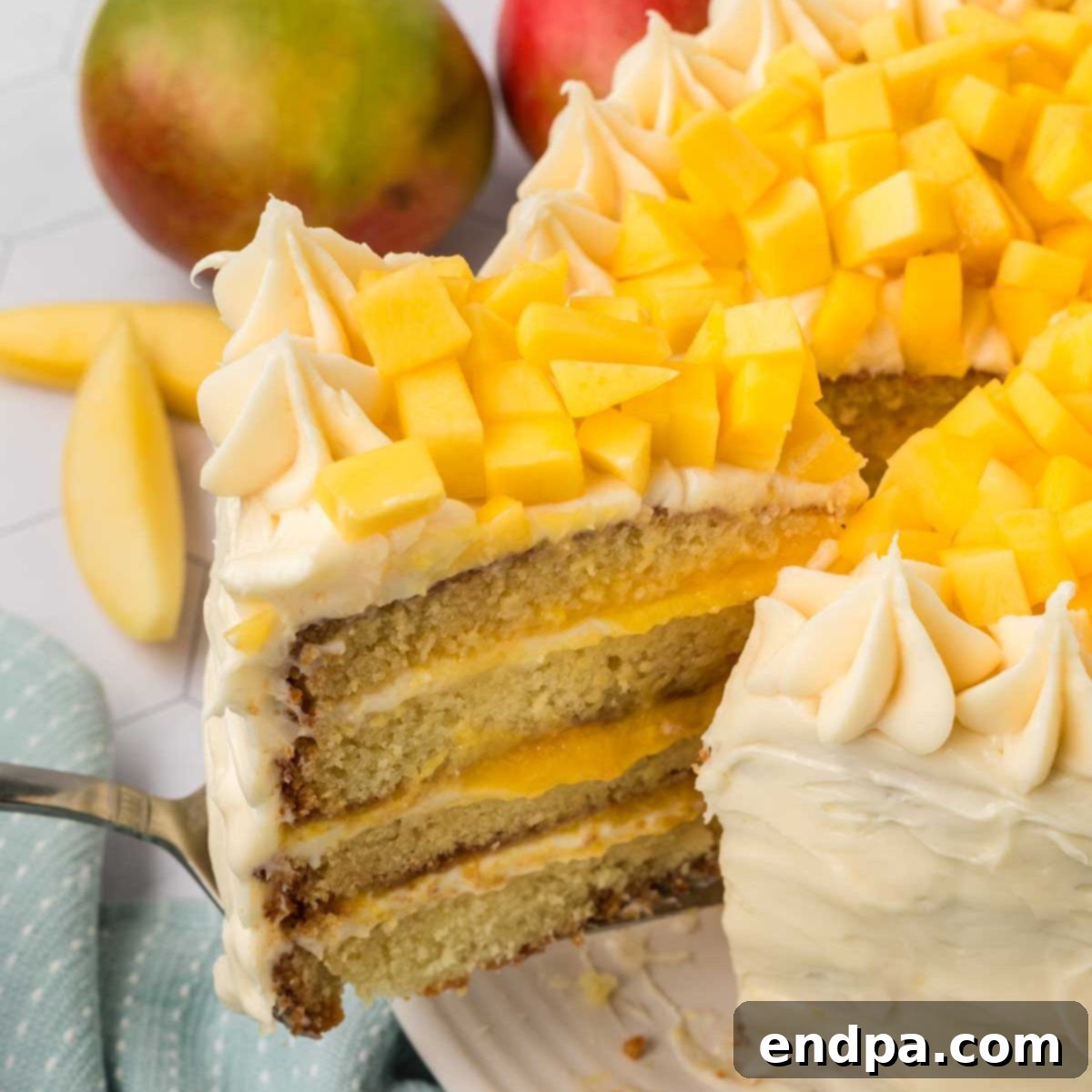Indulge in the vibrant flavors of the tropics with this exquisite Mango Cake. This show-stopping dessert features delicate layers of fluffy vanilla sponge cake, generously filled with luscious mango puree, and enrobed in a rich, tangy cream cheese frosting. Crowned with an abundance of fresh, juicy mango slices, every slice promises an unforgettable taste of sunshine.
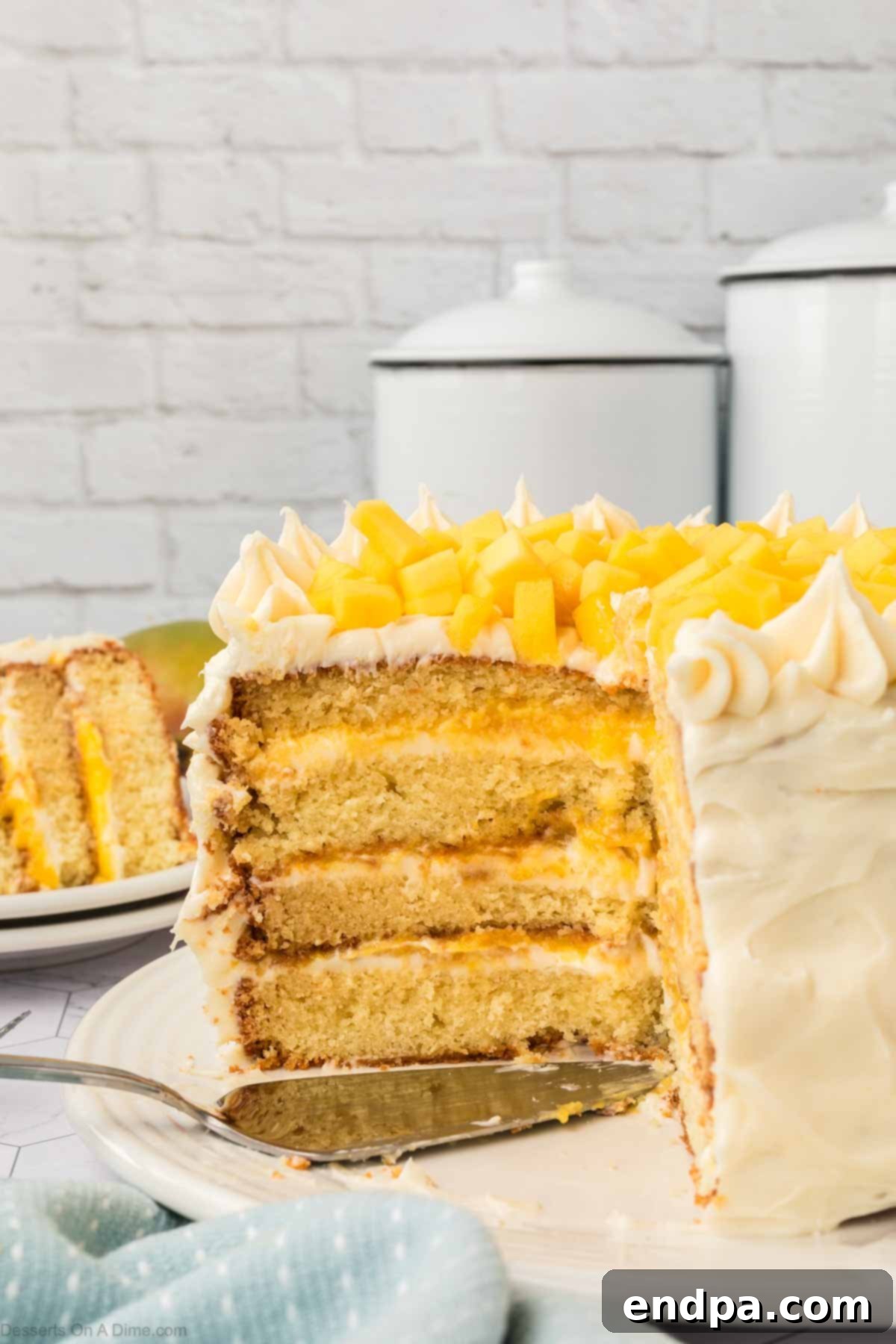
While this layer cake recipe might appear to be a masterpiece of confectionary art, rest assured that its creation is far simpler than you imagine. Our easy-to-follow, step-by-step instructions empower even novice bakers to whip up this Asian-inspired delight, brimming with authentic mango flavor. Each of its three delicious layers is infused with sweet mango puree, creating an incredibly moist and indulgent experience with every single bite. The harmonious blend of sweet, tart, and creamy textures makes this mango dessert truly irresistible.
Mangoes are a true gift of nature, offering a naturally sweet and aromatic profile perfect for desserts. If you find yourself with extra ripe mangoes after crafting this cake, don’t let them go to waste! Consider transforming them into refreshing Mango Popsicles for another delightful treat. Their tropical essence is a fantastic addition to any summer celebration.
Looking for more dessert inspiration for warmer days or festive occasions? Explore our collection of 4th of July Cake Ideas or discover the elegance of a classic Chantilly Cake. But for now, let’s dive into the magic of this homemade mango cake.
Table of Contents
- The Irresistible Allure of Mango Cake
- Why This Mango Cake Recipe is a Must-Try
- Key Ingredients for the Perfect Mango Cake
- For the Tender Vanilla Cake Layers
- For the Vibrant Mango Puree Filling and Fresh Topping
- For the Silky-Smooth Cream Cheese Frosting
- Creative Variations to Customize Your Mango Cake
- Mastering the Art of Mango Cake: Step-by-Step Guide
- Proper Storage for Optimal Freshness
- Expert Baking Tips for a Flawless Mango Cake
- Frequently Asked Questions About Mango Cake
The Irresistible Allure of Mango Cake
There’s something truly special about a homemade mango cake that captivates both the eye and the palate. This tropical dessert brings an immediate sense of joy and celebration, whether it’s for a birthday, a summer gathering, or simply a treat for yourself. The unique appeal of our mango cake lies in its perfect balance: a light, moist vanilla sponge that provides a comforting base, a rich and naturally sweet mango puree that delivers an authentic fruity burst, and a luscious cream cheese frosting that adds a delightful tangy counterpoint. It’s a symphony of textures and flavors that elevates it beyond a simple cake, transforming it into a memorable culinary experience.
The bright, sunny color of the mango, both in the puree and as a fresh topping, makes this cake an absolute visual stunner. When you slice into it, the beautiful layers are revealed, promising a mosaic of deliciousness in every forkful. This recipe embraces the vibrant essence of fresh mango, making it the star of the show. It’s a versatile dessert, perfect for those who appreciate fruity, refreshing flavors over overly sweet concoctions. Moreover, the “Asian-inspired” element points to a tradition of using fresh fruits elegantly in desserts, providing a lighter, more refined sweetness.
Why This Mango Cake Recipe is a Must-Try
This mango cake is more than just a dessert; it’s a celebration of fresh, natural flavors. Every single bite is bursting with the taste of ripe mango, creating a truly refreshing experience. The homemade mango puree isn’t just a filling; it gently soaks into the tender cake layers, infusing them with an unparalleled moistness and deep tropical aroma. This absorption process is key to achieving a truly decadent texture that simply melts in your mouth.
Beyond the incredible flavor, the sweetness of the cream cheese frosting beautifully complements the fruit. Its slight tanginess cuts through the sweetness of the mango, creating a balanced and utterly addictive profile. Visually, this cake is a showstopper. Once cut, the gorgeous layers of golden cake, vibrant orange puree, and pristine white frosting are elegantly displayed, making it look as pretty as it tastes. It’s the perfect dessert to impress guests or simply treat your family to something truly special. The combination of moist cake with all these fresh, high-quality ingredients makes this homemade mango cake incredibly decadent and a pure delight for any occasion.
If you’re a fan of tropical fruit desserts, you might also enjoy exploring other refreshing options like these 35 Pineapple Desserts. But for now, let’s gather our ingredients and prepare to create this masterpiece.
Key Ingredients for the Perfect Mango Cake
Crafting an exceptional mango cake begins with selecting the right ingredients. Each component plays a vital role in achieving the desired texture, flavor, and overall perfection of this tropical dessert. Here’s a detailed look at what you’ll need and why each element is crucial:
For the Tender Vanilla Cake Layers
- Cake Flour: This is the secret to an incredibly tender, soft, and airy cake crumb. Cake flour has a lower protein content than all-purpose flour, which means less gluten development and a more delicate texture. If you don’t have it on hand, you can easily learn How to Make Cake Flour at home using a simple method.
- Baking Powder & Baking Soda: These are our leavening agents, working in tandem to give the cake its beautiful lift and airy structure. Baking soda reacts with the acidic buttermilk, while baking powder provides additional leavening. If you’re out of baking soda, check out the Best Baking Soda Substitutes.
- Unsalted Butter: Always opt for real unsalted butter, softened at room temperature. Butter is essential not just for flavor, but also for contributing to the cake’s rich texture and moistness. It provides a superior depth of flavor compared to vegetable oil. Ensure it’s properly softened for a smooth, homogenous batter.
- Granulated Sugar: Provides sweetness and helps create a tender crumb by interfering with gluten formation. It also aids in moisture retention.
- Large Eggs: Use large eggs at room temperature. Room temperature eggs emulsify better with the butter and sugar, leading to a smoother batter and a more uniform, tender cake. They also contribute to the cake’s structure and richness.
- Pure Vanilla Extract: A touch of high-quality pure vanilla extract enhances all the other flavors in the cake, adding a warm, aromatic depth that complements the bright mango.
- Buttermilk: This ingredient is key for a moist cake with a subtle, pleasant tang. The acidity in buttermilk reacts with baking soda to create a light and airy texture. We highly recommend using buttermilk and do not suggest substituting it with regular milk, as it impacts both texture and flavor. If buttermilk isn’t readily available, you can easily make your own buttermilk substitute at home.
For the Vibrant Mango Puree Filling and Fresh Topping
- Ripe Mangos: The star of the show! It’s crucial to use ripe, sweet mangoes for the best flavor in both the puree and the fresh topping. Ripe mangoes will have a fragrant aroma, give slightly when gently squeezed, and often have a vibrant, colorful skin (though color alone isn’t always the best indicator of ripeness). Avoid unripe or overly soft mangoes.
- Granulated Sugar: The amount of sugar added to the mango puree is highly dependent on the natural sweetness of your chosen mangoes. Always taste your mango puree first and adjust the sugar gradually to achieve your preferred level of sweetness.
For the Silky-Smooth Cream Cheese Frosting
- Full-Fat, Brick-Style Cream Cheese: For the creamiest, most stable cream cheese frosting, always use full-fat, brick-style cream cheese. Whipped or spreadable cream cheese contains too much water and will result in a runny frosting. Ensure it’s softened at room temperature to prevent lumps.
- Unsalted Butter: Just like with the cake, unsalted butter is vital for the frosting. It allows you to control the saltiness of your dessert. Make sure it’s also softened to room temperature for optimal whipping and smoothness.
- Powdered Sugar (Confectioners’ Sugar): This is what gives the frosting its smooth, melt-in-your-mouth texture. It’s highly recommended to sift the powdered sugar before adding it to remove any lumps, ensuring a silky finish without gritty bits.
- Pure Vanilla Extract: Vanilla complements the cream cheese and mango beautifully, adding another layer of complex flavor to the frosting.
A comprehensive list with precise quantities of all ingredients can be found in the recipe card at the bottom of this article.
Creative Variations to Customize Your Mango Cake
While this mango cake recipe is perfect as written, it also serves as an excellent canvas for creativity. Feel free to experiment with these variations to tailor it to your taste or occasion:
- Frosting Alternatives: Instead of traditional cream cheese frosting, you could opt for a lighter Whipped Cream Frosting. This would result in an even airier and less sweet cake, perfect for those who prefer a subtler dessert. For a truly tropical twist, consider adding a hint of coconut extract to your whipped cream.
- Enhanced Mango Puree: To add an extra layer of brightness and to balance the sweetness, a squeeze of fresh lemon juice or lime juice can be added to the mango puree filling. Start with a small amount (½ teaspoon) and taste, adding more if desired. A pinch of ground ginger or cardamom could also introduce an interesting aromatic note.
- Cake Flavor Variations: While vanilla sponge is classic, you could infuse the cake batter with a tablespoon of coconut milk for a more pronounced tropical flavor, or even replace a portion of the flour with finely ground desiccated coconut for texture.
- Tropical Fruit Medley: Instead of just mango, consider layering the cake with a combination of tropical fruits. Passion fruit puree, finely diced pineapple, or even kiwi slices could be added alongside or in place of some of the mango for a fruit explosion.
- Spiced Mango: For a more exotic profile, gently simmer your mango puree with a tiny pinch of chili powder or a dash of cinnamon. This subtle spice can really elevate the mango flavor.
- Mini Mango Cakes: For individual servings or a dessert bar, bake the cake layers in smaller pans (e.g., 6-inch pans or even cupcake tins) and assemble mini layer cakes. Adjust baking times accordingly.
- Gluten-Free Option: With a few adjustments, this cake can be made gluten-free. Substitute the cake flour with a high-quality gluten-free all-purpose flour blend (one that contains xanthan gum). Ensure all other ingredients are also gluten-free.
Mastering the Art of Mango Cake: Step-by-Step Guide
Creating this beautiful and delicious mango cake is a rewarding process. Follow these detailed instructions carefully to ensure a perfect result every time.
- Step 1: Prepare Your Pans and Preheat Oven. Begin by preheating your oven to 350 degrees Fahrenheit (175°C). This ensures the oven is at the correct temperature when your batter is ready to bake, promoting an even rise. Thoroughly grease and flour two 8-inch round cake pans. Don’t skimp on this step – coat every nook and cranny to prevent sticking. We highly recommend using 8-inch pans as 9-inch pans will result in thinner cake layers, making them more challenging to slice horizontally for the desired four layers. For extra assurance, you can line the bottoms of the pans with parchment paper.

Step 2: Combine Dry Ingredients. In a medium mixing bowl, whisk together the cake flour, baking powder, baking soda, and salt. Whisking ensures these ingredients are evenly distributed, which is crucial for a consistent rise and texture throughout the cake. Set this mixture aside.

Step 3: Cream Butter and Sugar. In a separate, larger bowl (preferably of a stand mixer fitted with a paddle attachment, or using a handheld electric mixer), beat the softened butter and granulated sugar together. Beat on medium-high speed until the mixture is light, fluffy, and pale in color. This creaming process incorporates air, which contributes to the cake’s tender texture.
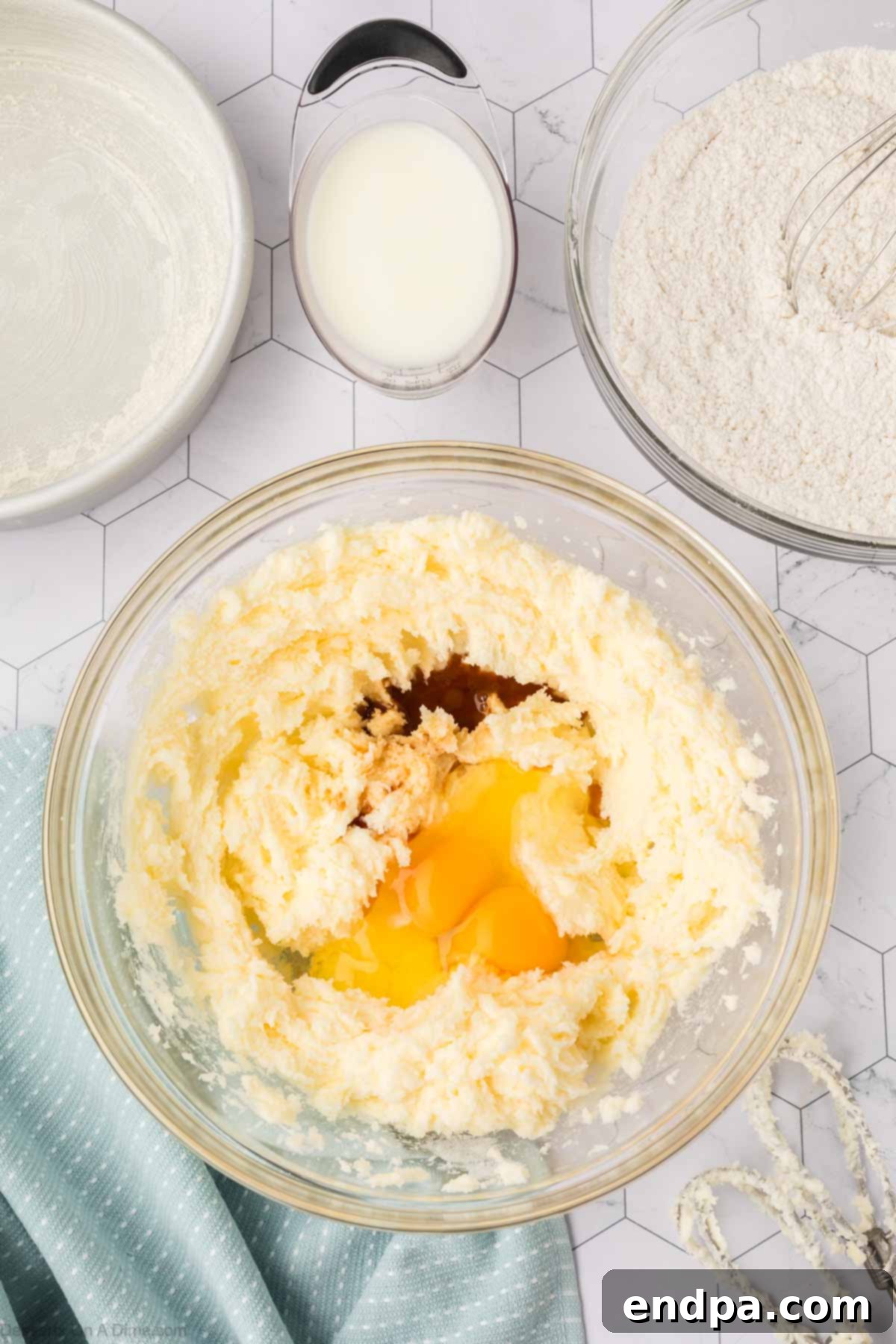
Step 4: Incorporate Eggs and Vanilla. Add the large eggs, one at a time, beating well after each addition until fully incorporated. Then, stir in the pure vanilla extract. Continue to mix until everything is just combined. Scrape down the sides of the bowl to ensure all ingredients are thoroughly blended.
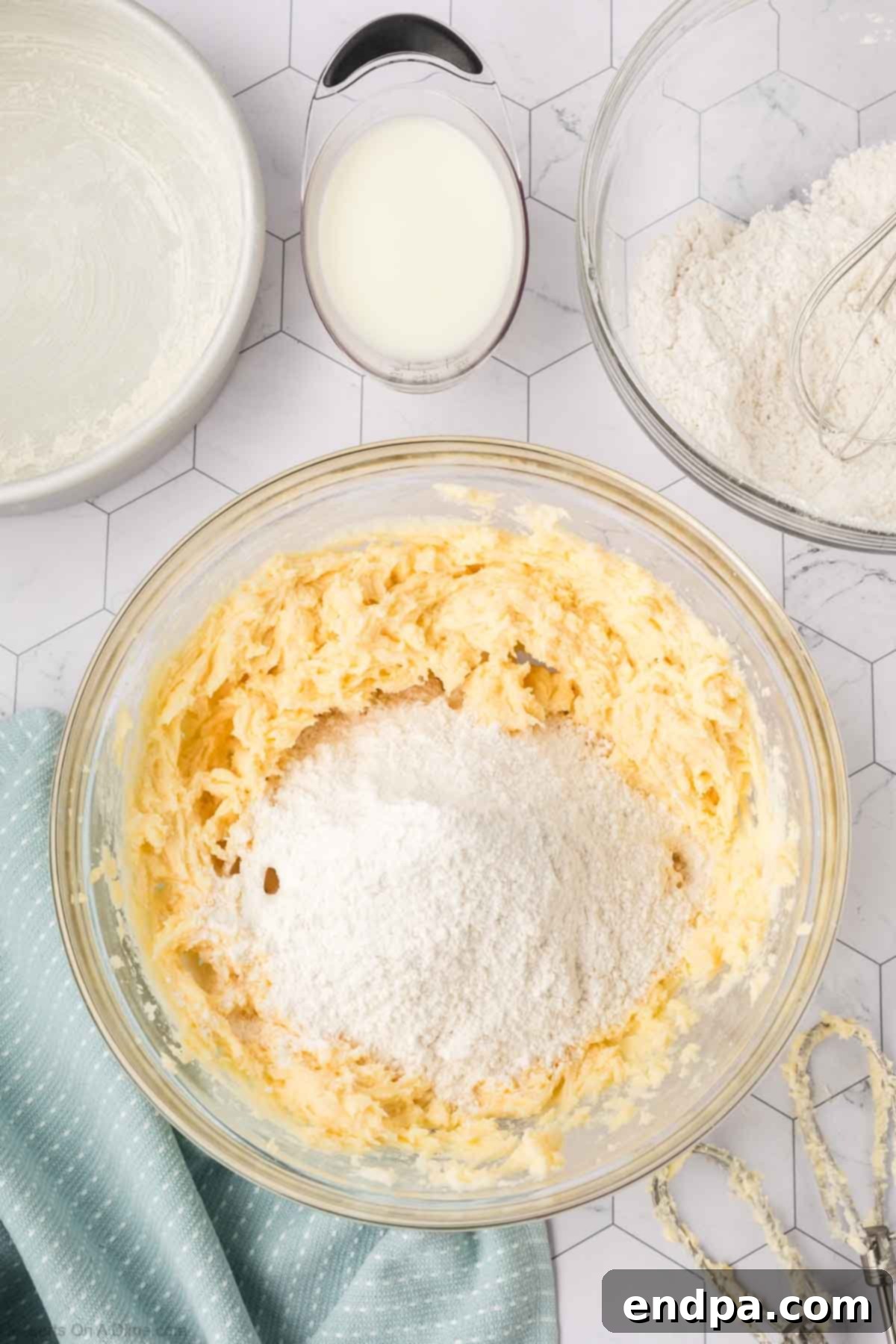
Step 5: Alternate Wet and Dry Ingredients. With the mixer on low speed, begin adding the flour mixture and buttermilk to the wet ingredients, alternating between them. Start and end with the flour mixture (e.g., 1/3 flour, 1/2 buttermilk, 1/3 flour, 1/2 buttermilk, 1/3 flour). This method helps create a stable emulsion and a tender crumb.

Step 6: Mix Until Just Combined. Mix the batter only until the ingredients are just combined. Be careful not to overmix, as overmixing develops gluten, which can lead to a tough and dense cake. A few small lumps are perfectly fine.
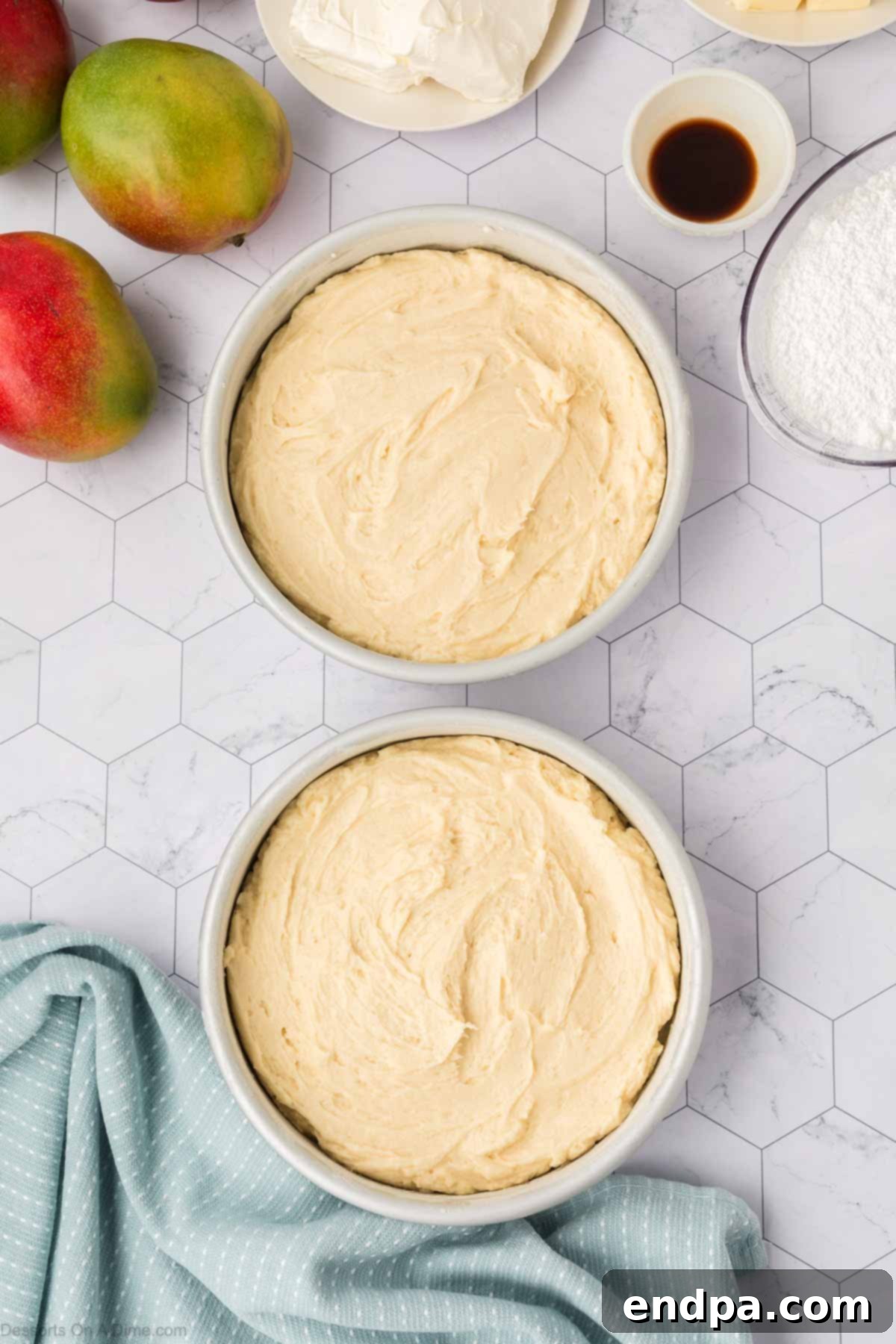
Step 7: Fill Pans Evenly. Divide the thick batter evenly between the two prepared round cake pans. You may need to use an offset spatula to spread it out smoothly to ensure an even top. Gently tap the pans on the countertop several times. This helps to release any trapped air bubbles, ensuring a uniform texture and preventing large air pockets in your baked cake.

Step 8: Bake the Cakes. Bake the cake layers in the preheated oven for 20-25 minutes, or until a wooden toothpick inserted into the center of the cakes comes out clean. Baking times can vary depending on your oven, so always rely on the toothpick test. Overbaking can lead to dry cakes.
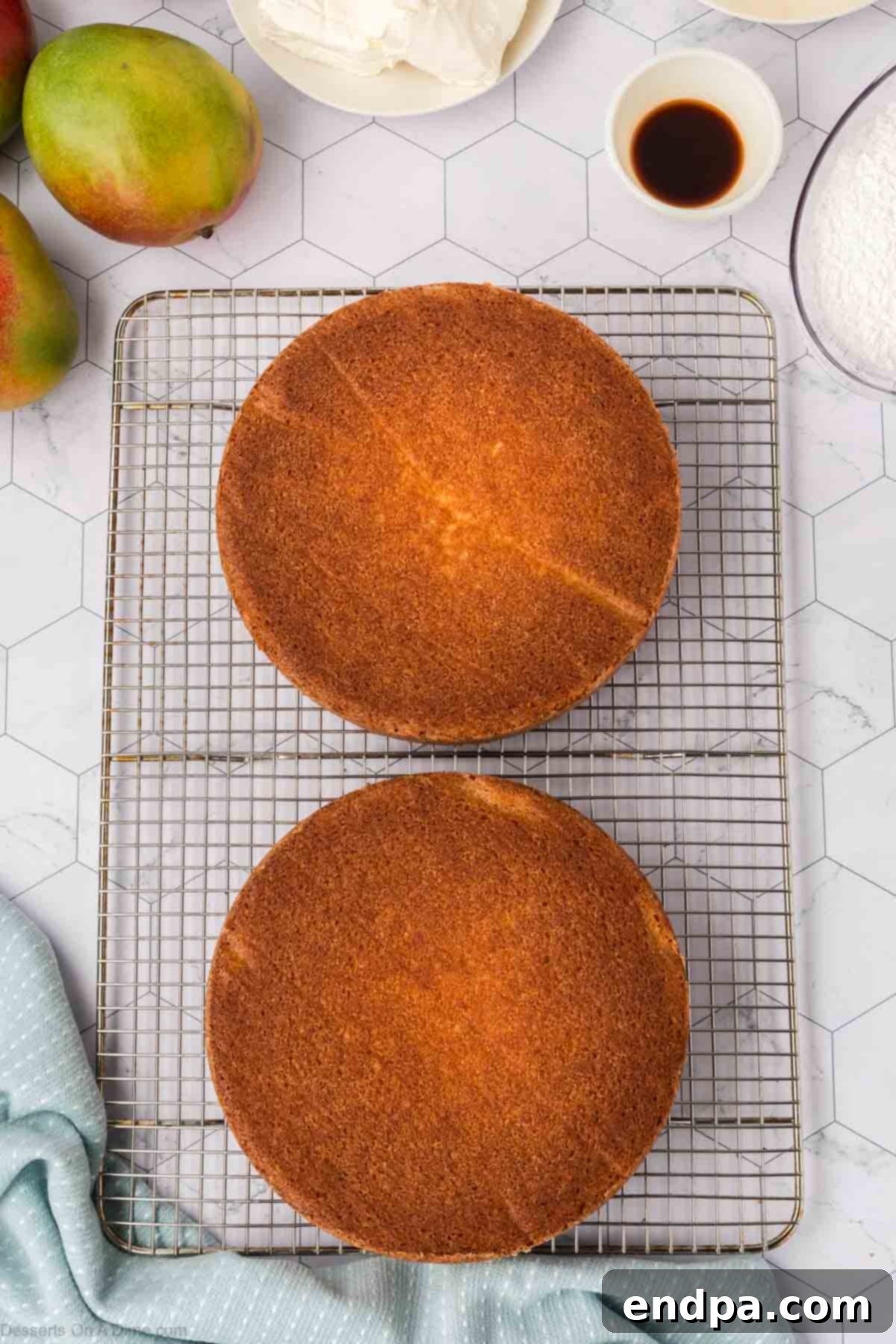
Step 9: Cool the Cakes. Allow the baked cakes to cool in their pans for about 5-10 minutes. This allows them to firm up slightly before handling. Then, carefully run a knife around the edges of each cake pan and invert the cakes onto a wire rack. Let them cool completely to room temperature. Attempting to frost or slice warm cakes will result in crumbling and melting frosting.

Step 10: Slice Cake Layers. Once the cakes are completely cool, carefully slice each 8-inch cake horizontally into two even layers. This will give you four beautiful cake layers for stacking. For best results, use a long serrated knife and a steady hand, or a cake leveler for perfectly even layers.
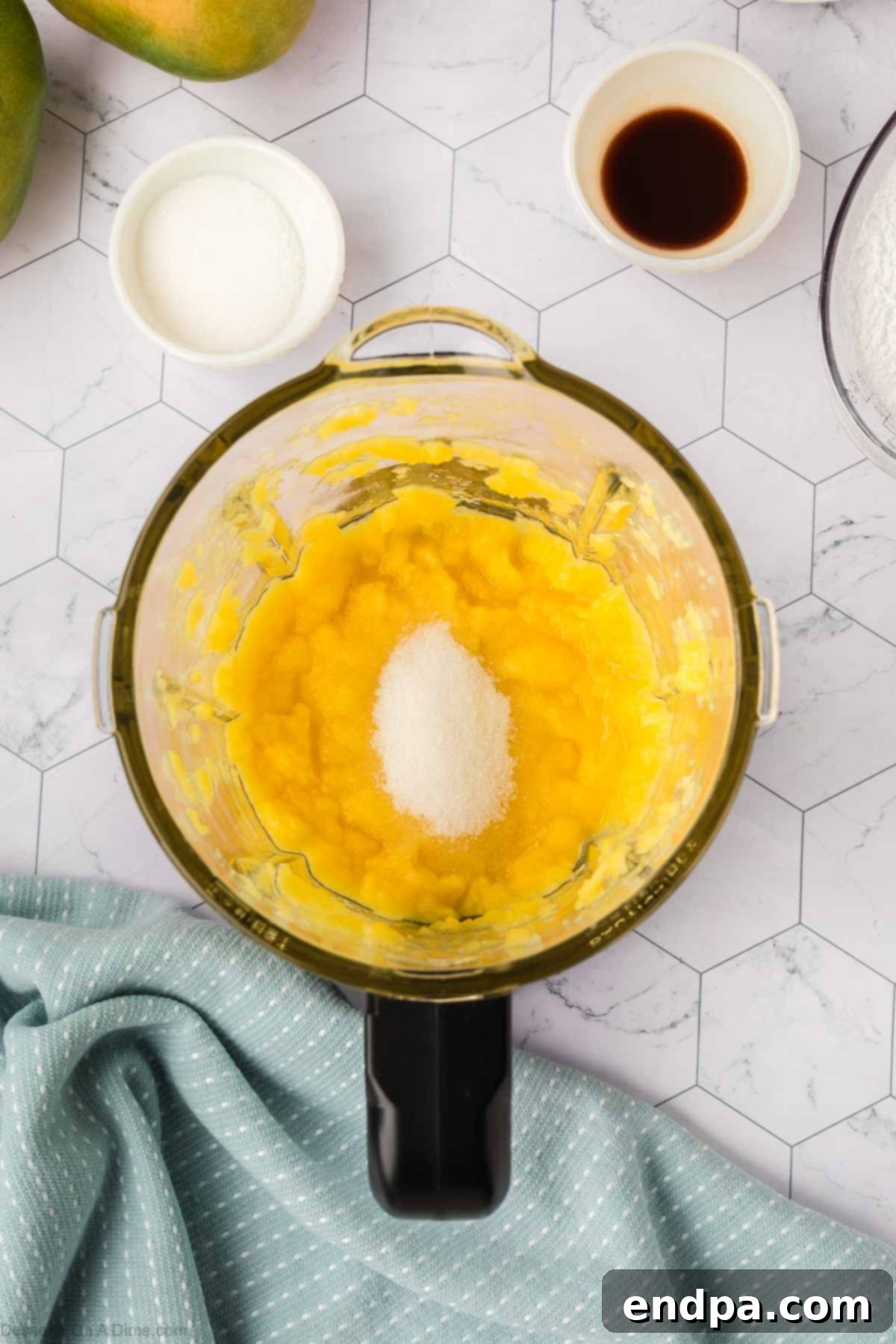
Step 11: Prepare Mango Puree. Take two of your ripe mangoes, peel and pit them, then chop them into chunks. Place these mango chunks in a blender or food processor. Blend until you achieve a perfectly smooth puree. This will form the luscious filling between your cake layers.
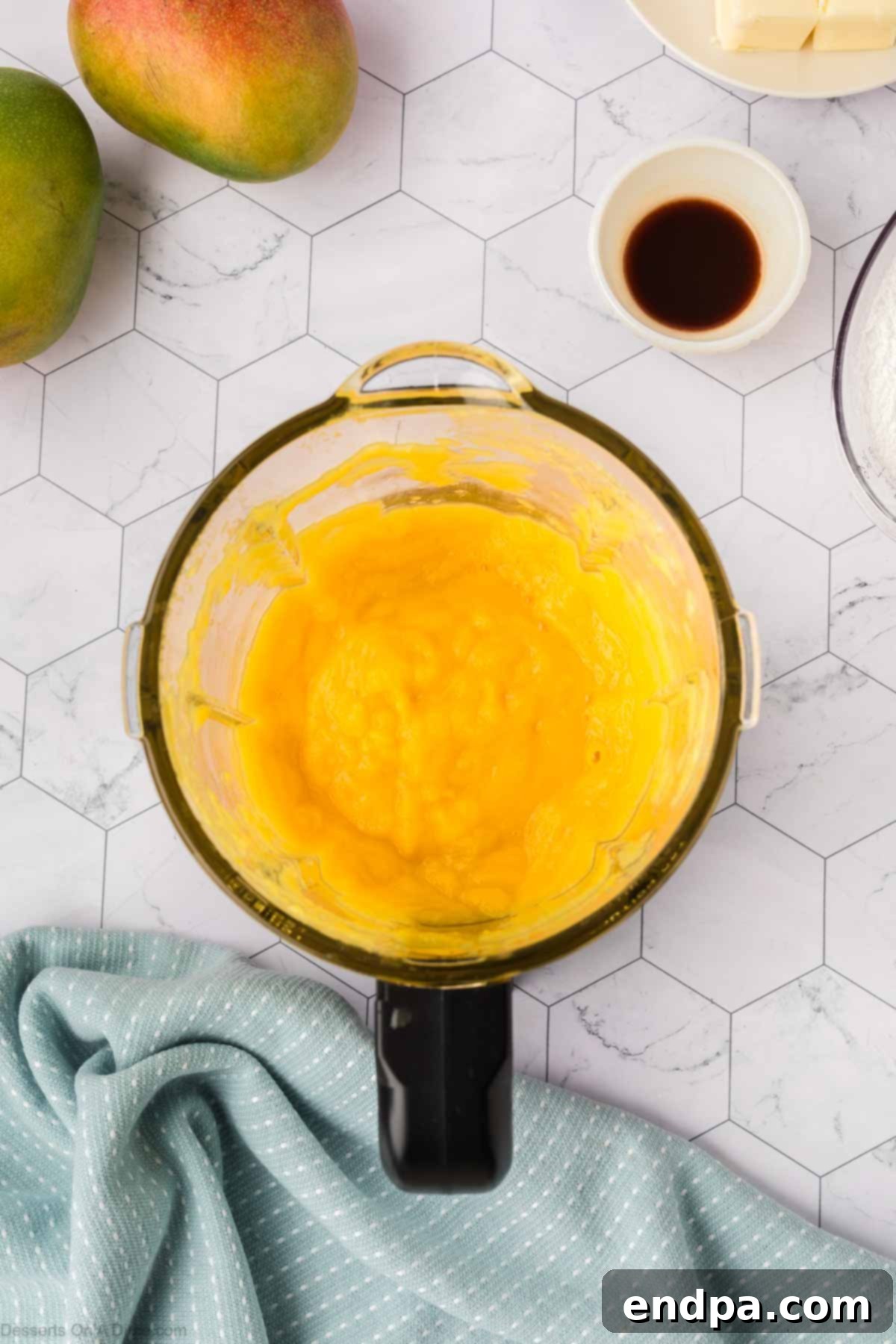
Step 12: Adjust Puree Sweetness. Now for a crucial step: taste your mango puree. The natural sweetness of mangoes can vary greatly. Add granulated sugar one tablespoon at a time, blending after each addition, until the puree reaches your desired level of sweetness. Remember, you can always add more, but you can’t take it away!
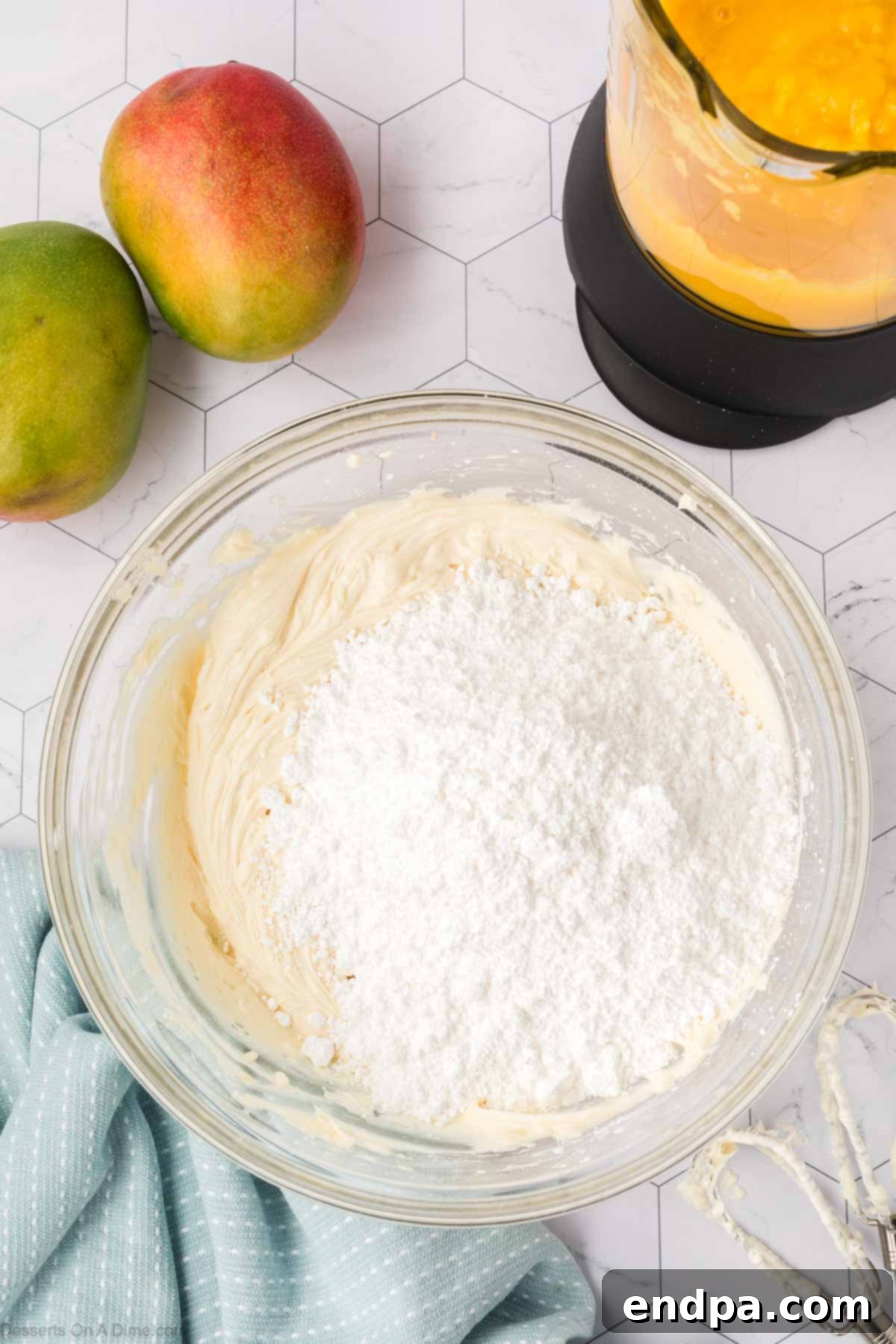
Step 13: Make the Cream Cheese Frosting – Initial Mix. In the bowl of a stand mixer (or using a handheld electric mixer), combine the softened full-fat cream cheese, softened unsalted butter, pure vanilla extract, and 1 ¼ cups of the sifted powdered sugar. Start beating on low speed until the ingredients are just combined and no dry streaks of powdered sugar remain. Then increase the speed to high and beat until the mixture is smooth and slightly creamy.
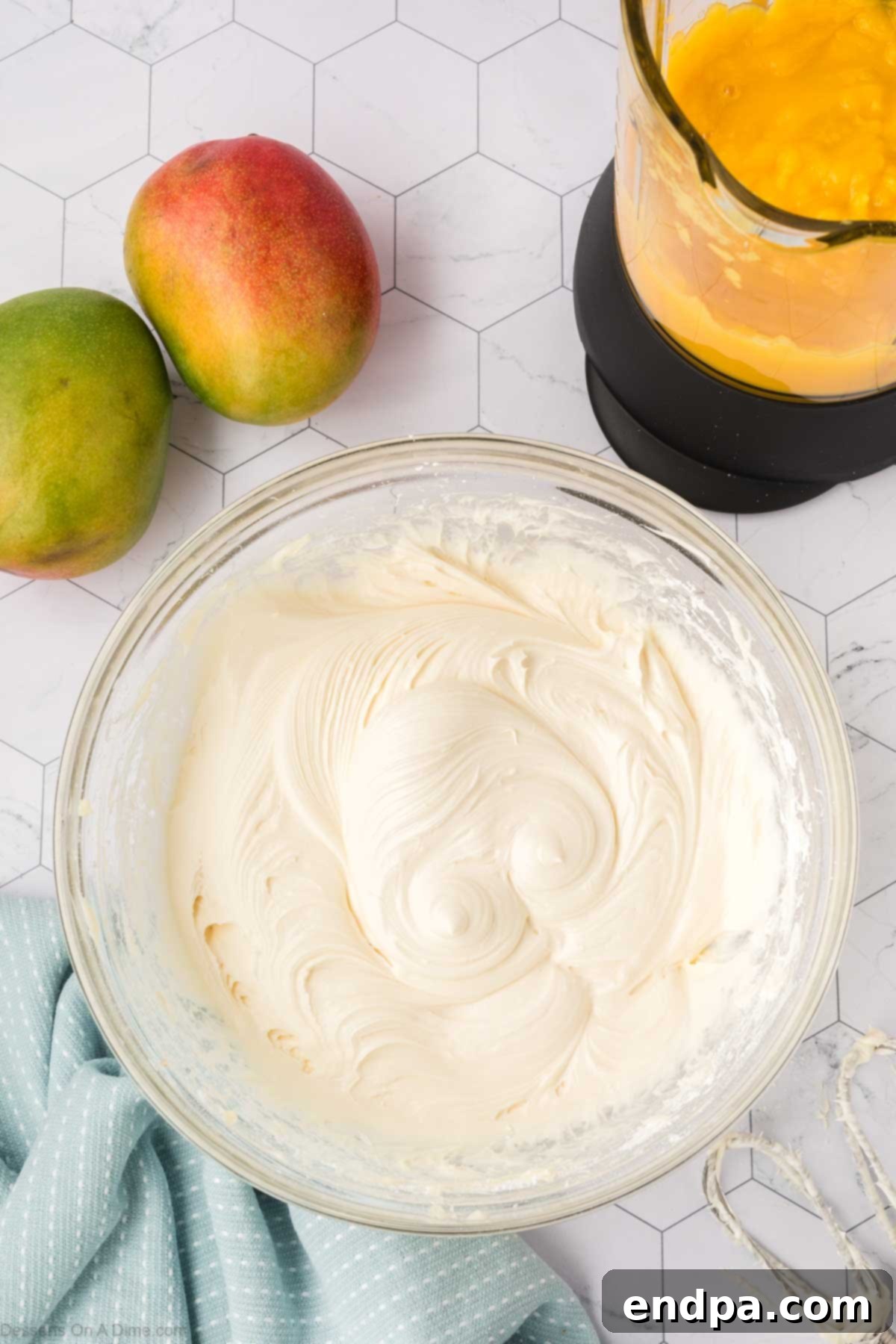
Step 14: Finish the Frosting. Add the remaining powdered sugar to the bowl. Mix again on low speed until it’s just combined to avoid a powdered sugar cloud. Once incorporated, increase the speed to high and beat for 4-5 minutes. During this time, periodically scrape down the sides and bottom of the bowl to ensure everything is thoroughly mixed. The goal is a light, airy, and incredibly fluffy cream cheese frosting. Be careful not to overbeat, as this can sometimes cause the cream cheese to become too soft.

Step 15: Begin Cake Assembly. Place your first cake layer onto a cake stand or serving platter. A small dollop of frosting on the platter before placing the cake can help anchor it and prevent it from sliding during assembly.
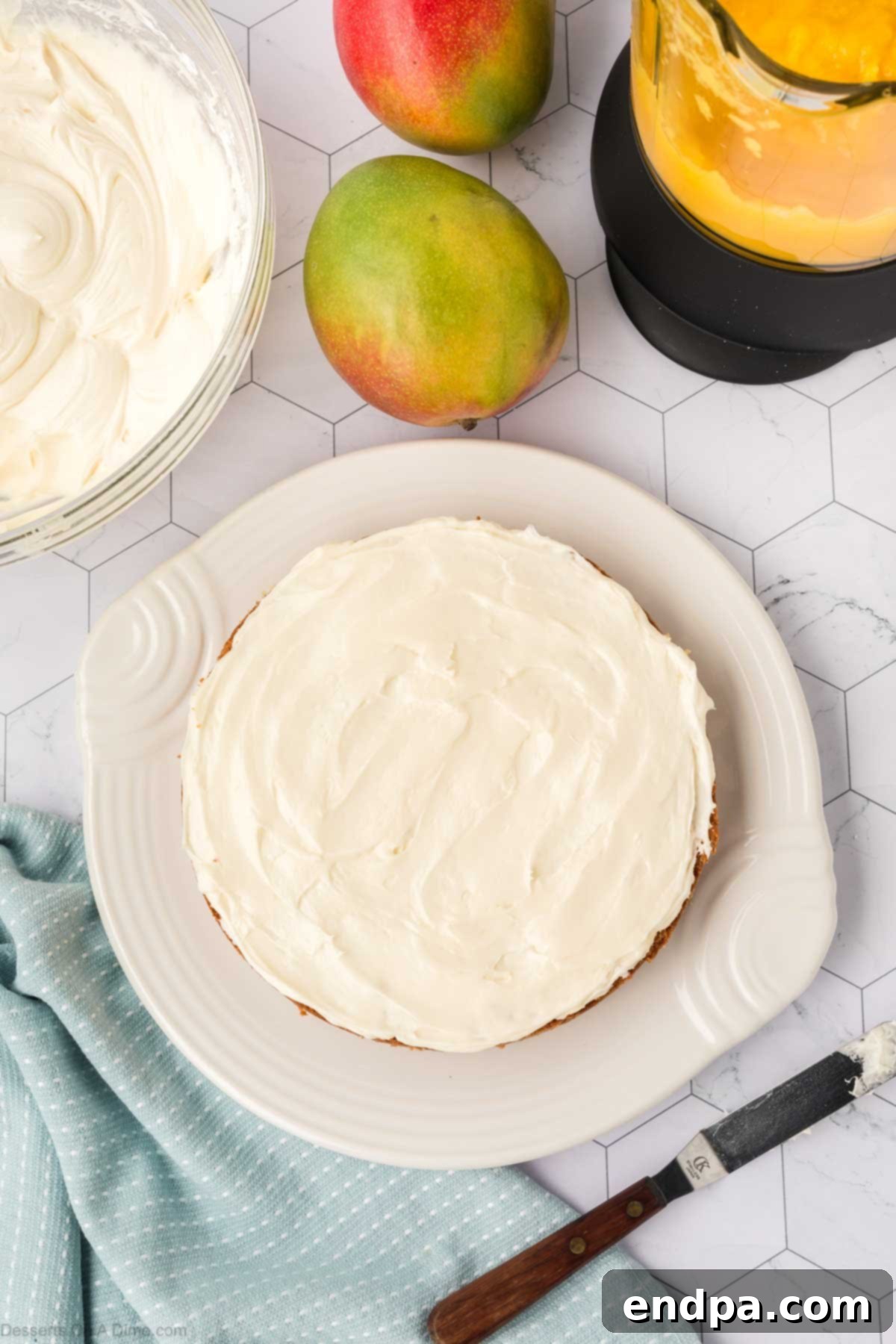
Step 16: Add Frosting Layer. Generously spread an even layer of cream cheese frosting over the first cake layer. Use an offset spatula for a smooth finish.
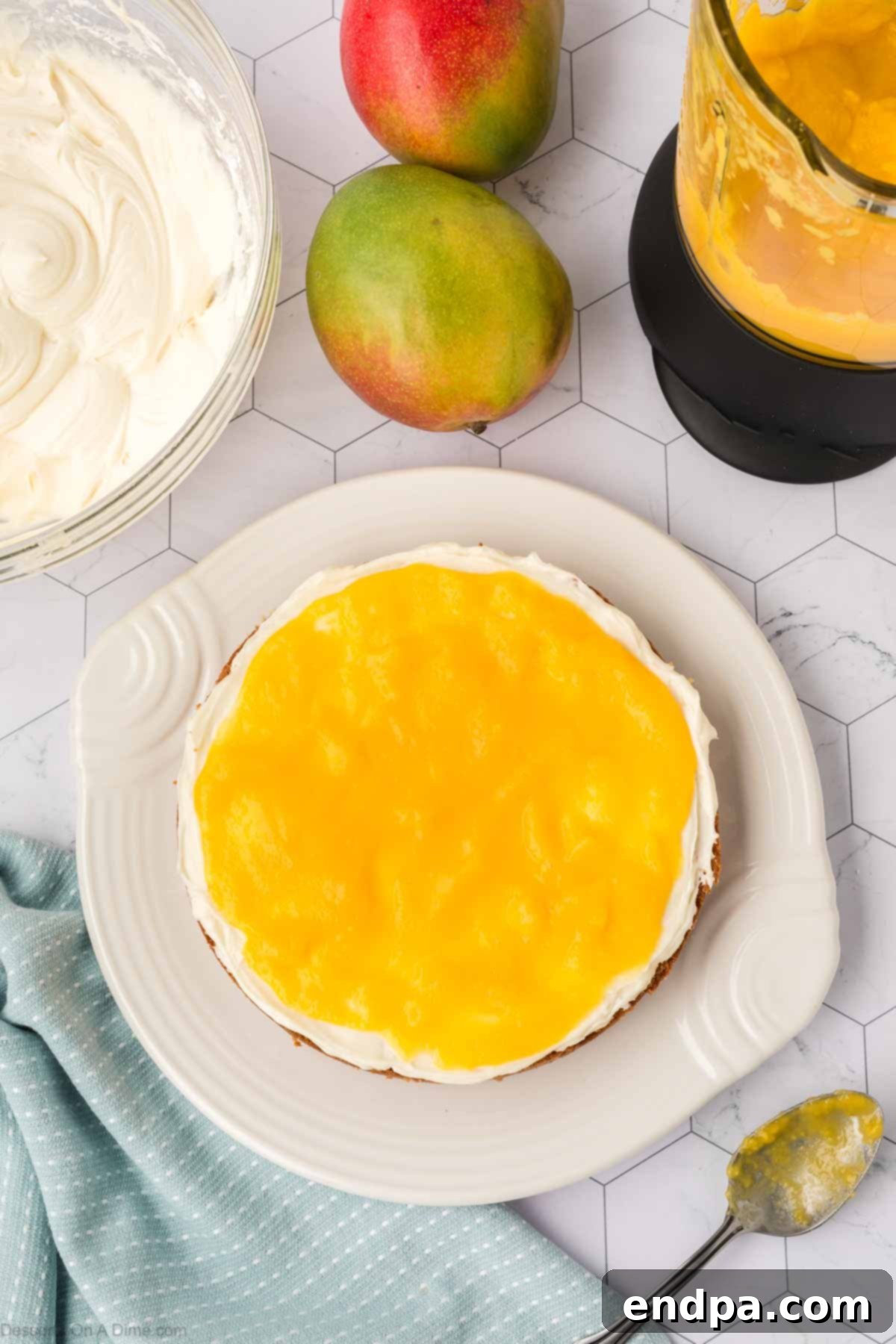
Step 17: Add Mango Filling. Carefully spoon and spread a layer of the luscious mango puree over the frosting. Leave a small border around the edge to prevent the puree from oozing out when the next cake layer is added.

Step 18: Stack and Frost. Repeat steps 16 and 17 with the remaining cake layers, frosting, and mango puree, ensuring each layer is topped with both frosting and puree. Place the final cake layer on top. Then, use the remaining cream cheese frosting to cover the entire cake – both the sides and the top – in a smooth, even layer. You can do a “crumb coat” first (a thin layer to trap crumbs), chill it for 15-20 minutes, then apply the final, thicker coat for a professional finish.
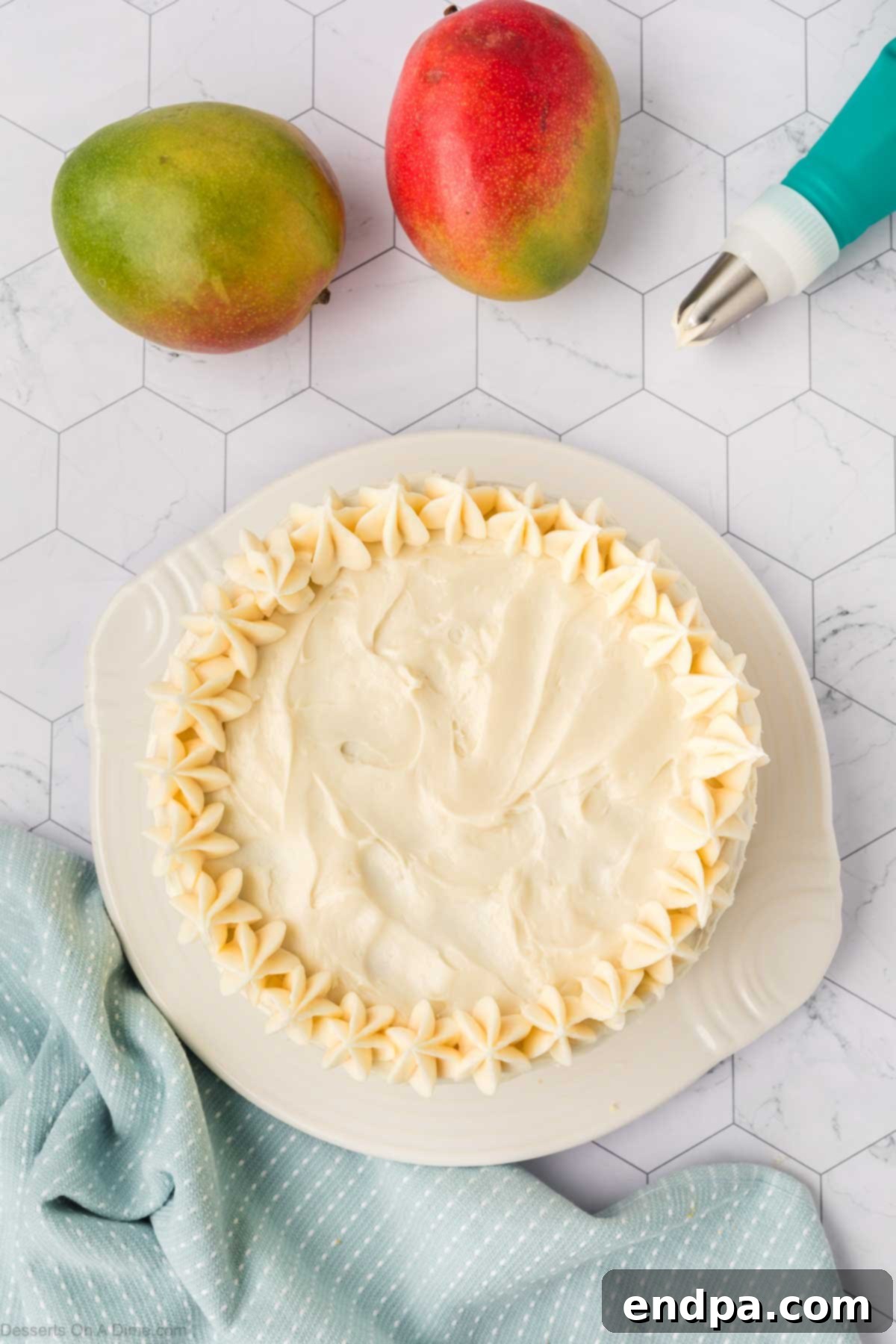
Step 19: Decorate the Border. For an elegant touch, transfer some of the remaining frosting into a piping bag fitted with a star tip (or your favorite decorative tip). Carefully pipe a decorative border around the outer top edge of the cake. This creates a beautiful frame for the fresh mango topping.

Step 20: Dice Fresh Mango for Topping. Take the remaining two fresh mangoes. Peel, pit, and carefully dice them into small, uniform cubes. The cleaner the cuts, the more professional your cake will look.

Step 21: Final Garnish and Chill. Gently arrange the diced fresh mango pieces on top of the cake, nestling them within the piped frosting border. For best results and to allow the flavors to meld beautifully, refrigerate the assembled cake for at least 1-2 hours before slicing. This also helps the frosting set. When ready to serve, slice and enjoy this magnificent tropical creation! It is also particularly delicious served alongside a scoop of homemade No-Churn Vanilla Ice Cream.
Proper Storage for Optimal Freshness
To keep your delicious mango cake fresh and flavorful, proper storage is essential, especially given the fresh fruit and cream cheese frosting. The cake should always be stored in the refrigerator. Place it inside an airtight cake container or cover it loosely with plastic wrap to prevent it from drying out or absorbing other odors from the fridge. Stored correctly, your mango cake will remain fresh for up to 3 days. For the best presentation, we recommend adding the fresh diced mango topping just before serving if you are making the cake ahead of time. This prevents the mango from softening or releasing too much moisture onto the cake surface.
For longer storage, you can freeze individual slices or the entire cake (without fresh mango topping) tightly wrapped in plastic wrap and then foil. It will keep well in the freezer for up to 1 month. Thaw in the refrigerator overnight before serving. Understanding How Long Does Birthday Cake Last can also provide helpful insights for general cake storage.
Expert Baking Tips for a Flawless Mango Cake
- Ensure Cakes Are Completely Cool: This cannot be stressed enough. Allow the cake layers to cool completely on a wire rack before attempting to cut them in half or frost them. Warm cakes are delicate and will crumble easily, and warm frosting will simply melt and slide off, creating a messy result. Patience is key!
- Taste and Adjust Sugar in Puree: The sweetness of mangoes varies significantly depending on the variety and ripeness. Always taste your mango puree after blending and adjust the granulated sugar gradually. Start with a small amount, blend, and taste again. This ensures your filling perfectly complements the cake and frosting without being overly sweet or too tart.
- Do Not Overmix the Batter: When combining the wet and dry ingredients, stir until they are just combined. Overmixing develops the gluten in the flour, which can lead to a dense, tough, and chewy cake rather than the desired light and tender crumb. Stop mixing as soon as no dry streaks of flour are visible.
- Thoroughly Coat Your Cake Pans: To prevent your beautiful cake layers from sticking and breaking, ensure your cake pans are thoroughly greased and floured. This creates a non-stick barrier. Alternatively, for foolproof removal, you can line the bottoms of your pans with parchment paper after greasing, then grease and flour the sides.
- Room Temperature Ingredients: For both the cake batter and the cream cheese frosting, ensure your butter, eggs, and cream cheese are at room temperature. This allows them to emulsify properly, creating a smooth, lump-free batter and a light, fluffy frosting.
- Sift Powdered Sugar: Always sift your powdered sugar for the frosting. This simple step removes any lumps, guaranteeing a super smooth and silky cream cheese frosting without any gritty texture.
- Sharp Serrated Knife for Slicing: When slicing your cooled cake layers horizontally, use a long, sharp serrated knife. This will help you achieve clean, even cuts without tearing or crushing the delicate cake. A cake leveler is also an excellent tool for precision.
- Chill Your Assembled Cake: After frosting and assembling, chilling the cake for at least an hour helps the frosting set and the layers to stabilize. This makes for much cleaner slicing and allows the flavors to meld beautifully.
Frequently Asked Questions About Mango Cake
This mango cake is specifically designed to be light, airy, and more akin to a delicate sponge cake. Cake flour is instrumental in achieving this tender texture due to its lower protein content, which results in less gluten formation. While you technically *can* use all-purpose flour, it will yield a denser, chewier cake, which is not the intended texture for this recipe. For the best results, we strongly recommend sticking to cake flour or making your own substitute.
Yes, you can absolutely use frozen mango chunks to make the mango puree for the filling. Just ensure they are thawed completely before blending. However, for the fresh mango topping, fresh, ripe mangoes are highly recommended. Frozen mangoes tend to become too soft and watery when thawed, which wouldn’t provide the appealing texture and vibrant appearance you want for the garnish.
For the purest flavor, opt for sweet, less fibrous mango varieties like Ataulfo (honey mango), Alphonso, or Haden. Kent and Tommy Atkins mangoes also work well if they are fully ripe. The key is ripeness; ensure your mangoes are fragrant and slightly soft to the touch for the best puree and topping.
Yes, this cake can be partially or fully made ahead. You can bake the cake layers up to 2 days in advance, wrap them tightly in plastic wrap, and store them at room temperature or in the fridge. The mango puree can also be made a day ahead and stored in an airtight container in the refrigerator. The cream cheese frosting can be made 1-2 days ahead and stored in the fridge; just re-whip it briefly before assembling. For the best taste and appearance, assemble and frost the cake no more than 1 day before serving, and add the fresh mango topping right before presentation.

More Delicious Layer Cake Recipes You’ll Love
Cakes
Chocolate Mousse Cake
Cakes
Lemon Blackberry Cake
Cakes
Atomic Cake
Cakes
Strawberry Crunch Cake
We invite you to bake this incredibly light, flavorful, and utterly delicious Mango Cake recipe at home. Experience the joy of creating a tropical masterpiece! Please share your experience and thoughts by leaving a comment below. We love hearing from you!
Pin
Mango Cake
35
25
1
10
American
Dessert
1099
Carrie Barnard
Ingredients
For the Cake:
- 2 ¼ cups cake flour
- 1 ½ teaspoon baking powder
- 1 teaspoon baking soda
- ½ teaspoon salt
- 2 cups butter softened
- 1 ½ cups granulated sugar
- 2 large eggs
- 2 ½ teaspoon vanilla extract
- ¾ cup buttermilk
For the Filling and Topping:
- 4 Mangos
- 1-3 Tablespoons Granulated Sugar
For the Cream Cheese Frosting:
- 16 oz Cream Cheese softened
- 1 Cup Unsalted Butter softened
- 3 ¼ cup Powdered Sugar
- 2 teaspoon vanilla extract
Instructions
For the Cake:
- Preheat the oven to 350 degrees F (175°C). Thoroughly grease and flour two 8″ round pans, ensuring all surfaces are coated to prevent sticking.
- In a large mixing bowl, whisk together the cake flour, baking powder, baking soda, and salt until well combined. Set aside.
- In a separate, larger bowl (using a stand mixer or handheld electric mixer), beat the softened butter and granulated sugar together until light, fluffy, and pale in color, about 2-3 minutes.
- Add the large eggs one at a time, mixing well after each addition. Stir in the vanilla extract until just combined. Scrape down the sides of the bowl as needed.
- With the mixer on low speed, alternate adding the dry flour mixture with the buttermilk, beginning and ending with flour. Mix only until just combined; do not overmix.
- Divide the thick batter evenly between the two prepared cake pans. Use a spatula to spread it smoothly. Gently tap the pans on the countertop several times to release air bubbles.
- Bake for 20-25 minutes, or until a wooden toothpick inserted into the center of the cakes comes out clean.
- Allow the cakes to cool in their pans for 5-10 minutes. Then, carefully invert them onto a wire rack to cool completely to room temperature before proceeding.
- Once the cake layers are completely cool, use a long serrated knife or cake leveler to carefully slice each cake horizontally into two even layers, resulting in four layers in total.
For the Mango Puree Filling:
- Peel, pit, and chop 2 of the ripe mangoes. Place the mango chunks in a blender or food processor and blend until perfectly smooth.
- Taste the mango puree. Depending on the sweetness of your mangoes, add granulated sugar 1 tablespoon at a time, blending after each addition, until you reach your desired sweetness level. Set aside.
For the Cream Cheese Frosting:
- In a large mixing bowl, combine the softened cream cheese, softened unsalted butter, vanilla extract, and 1 ¼ cups of sifted powdered sugar. Beat on low speed until just combined, then increase to high speed and beat until smooth and slightly creamy.
- Add the remaining 2 cups of sifted powdered sugar. Mix on low speed until incorporated, then increase to high speed and beat for 4-5 minutes, scraping down the bowl as needed. Beat until the frosting is light, airy, and fluffy.
Assemble the Mango Cake:
- Place the first cake layer onto a cake stand or serving platter. A small dollop of frosting can help secure it.
- Evenly spread a layer of cream cheese frosting over the first cake layer, followed by a layer of mango puree. Leave a small border for the puree.
- Repeat this layering process with the remaining cake layers, frosting, and mango puree, ensuring the top layer receives only frosting.
- Apply a thin crumb coat of frosting to the entire cake (sides and top) and chill for 15-20 minutes. Then, apply the remaining frosting for a smooth, final coat.
- Transfer some leftover frosting into a piping bag fitted with a star tip. Pipe a decorative border around the outer top edge of the cake.
- Dice the remaining 2 fresh mangoes into small, even cubes.
- Carefully arrange the diced mango pieces on top of the cake, inside the piped frosting border.
- Refrigerate the assembled cake for at least 1-2 hours before slicing to allow flavors to meld and frosting to set. Slice, serve, and enjoy your delightful homemade mango cake!
Nutrition Facts
Carbohydrates 107g,
Protein 9g,
Fat 73g,
Saturated Fat 45g,
Polyunsaturated Fat 3g,
Monounsaturated Fat 19g,
Trans Fat 2g,
Cholesterol 227mg,
Sodium 760mg,
Potassium 284mg,
Fiber 2g,
Sugar 84g,
Vitamin A 3285IU,
Vitamin C 30mg,
Calcium 136mg,
Iron 1mg
Pin This Now to Remember It Later
Pin Recipe
